Higher Education Study Skills: A Personal Reflection on the VARK Model
VerifiedAdded on 2023/06/15
|6
|1326
|58
Essay
AI Summary
This essay explores study skills in higher education, focusing on the VARK model, which includes visual, aural, read/write, and kinesthetic learning styles. The VARK model suggests that students learn better when teaching and academic activities align with their preferred learning styles. The essay discusses each learning style in detail, including the characteristics and supportive tools for visual, auditory, read/write, and kinesthetic learners. A personal experience is shared, highlighting the preference for read/write learning and the use of techniques like messy notes and exercise to enhance learning. The conclusion emphasizes the importance of learning styles and techniques in improving a student's academic life. Desklib provides a wealth of study resources for students.
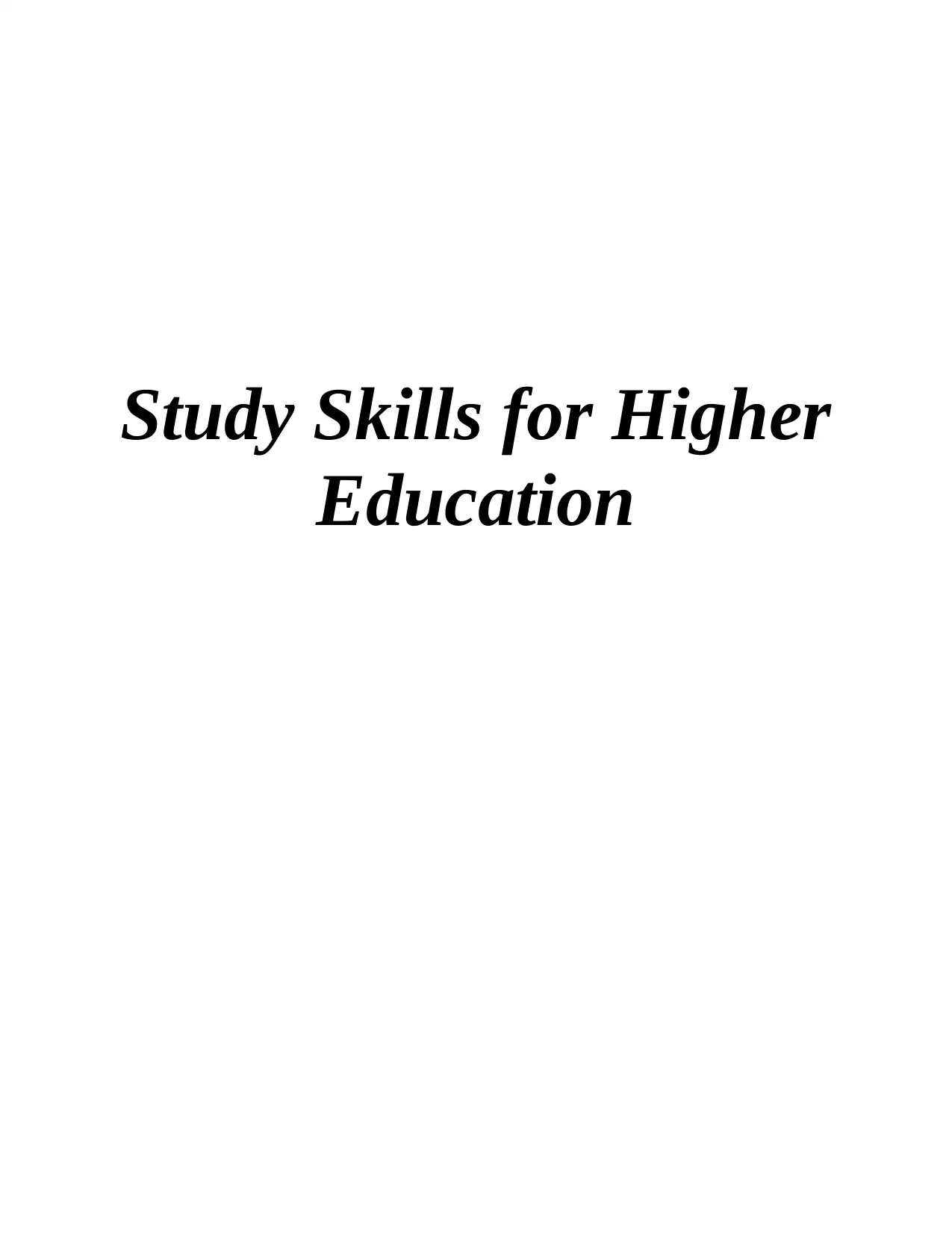
Study Skills for Higher
Education
Education
Paraphrase This Document
Need a fresh take? Get an instant paraphrase of this document with our AI Paraphraser
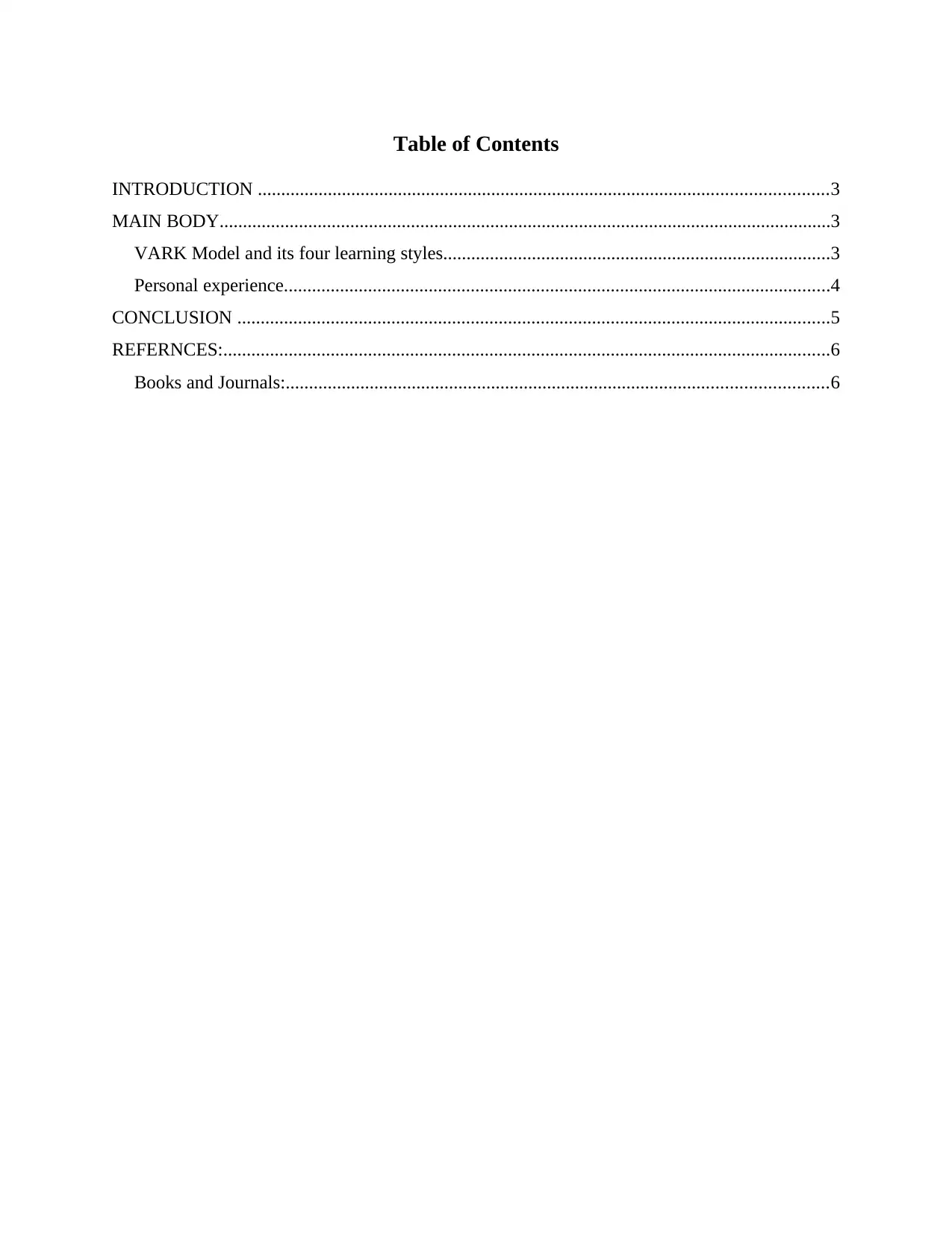
Table of Contents
INTRODUCTION ..........................................................................................................................3
MAIN BODY...................................................................................................................................3
VARK Model and its four learning styles...................................................................................3
Personal experience.....................................................................................................................4
CONCLUSION ...............................................................................................................................5
REFERNCES:..................................................................................................................................6
Books and Journals:....................................................................................................................6
INTRODUCTION ..........................................................................................................................3
MAIN BODY...................................................................................................................................3
VARK Model and its four learning styles...................................................................................3
Personal experience.....................................................................................................................4
CONCLUSION ...............................................................................................................................5
REFERNCES:..................................................................................................................................6
Books and Journals:....................................................................................................................6
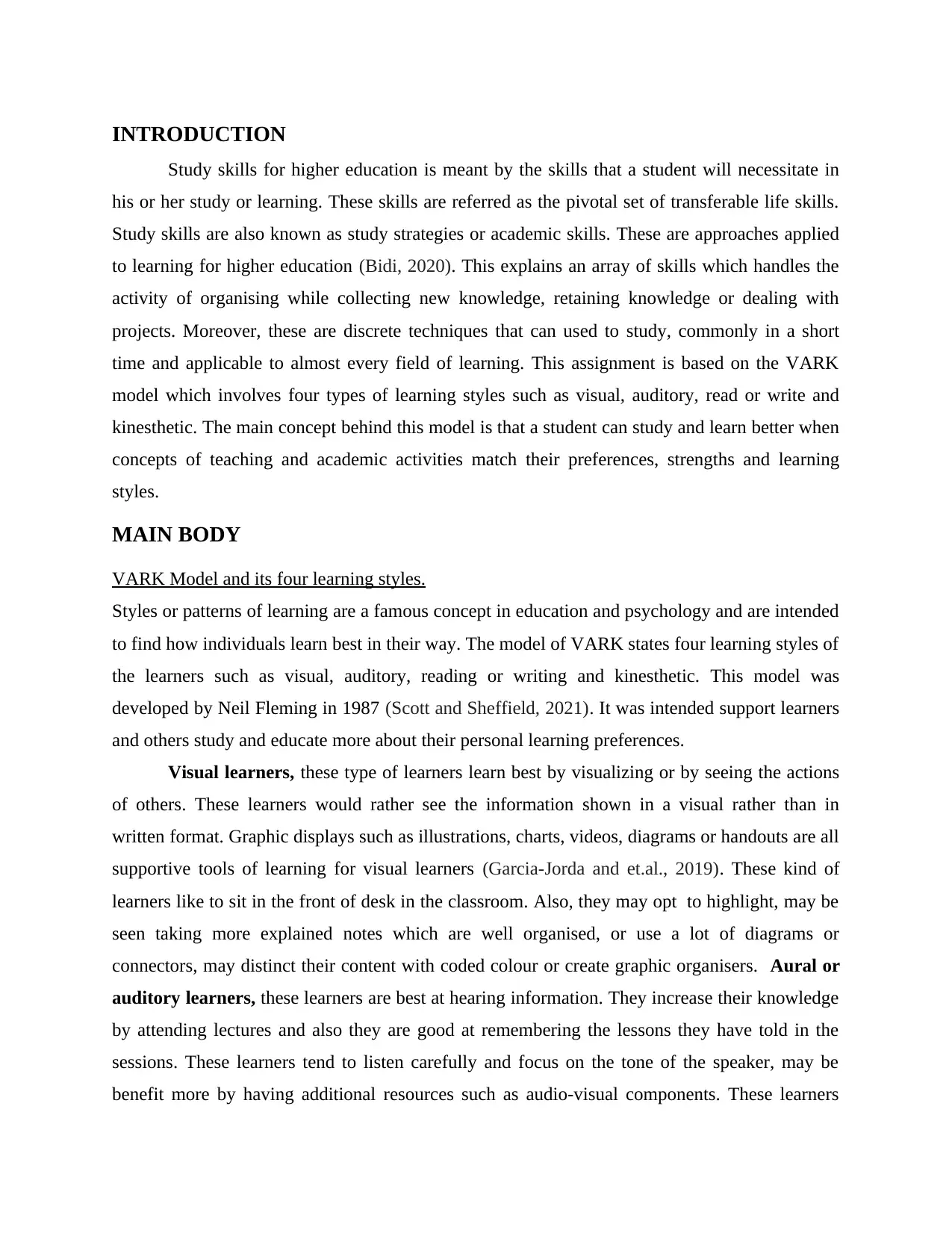
INTRODUCTION
Study skills for higher education is meant by the skills that a student will necessitate in
his or her study or learning. These skills are referred as the pivotal set of transferable life skills.
Study skills are also known as study strategies or academic skills. These are approaches applied
to learning for higher education (Bidi, 2020). This explains an array of skills which handles the
activity of organising while collecting new knowledge, retaining knowledge or dealing with
projects. Moreover, these are discrete techniques that can used to study, commonly in a short
time and applicable to almost every field of learning. This assignment is based on the VARK
model which involves four types of learning styles such as visual, auditory, read or write and
kinesthetic. The main concept behind this model is that a student can study and learn better when
concepts of teaching and academic activities match their preferences, strengths and learning
styles.
MAIN BODY
VARK Model and its four learning styles.
Styles or patterns of learning are a famous concept in education and psychology and are intended
to find how individuals learn best in their way. The model of VARK states four learning styles of
the learners such as visual, auditory, reading or writing and kinesthetic. This model was
developed by Neil Fleming in 1987 (Scott and Sheffield, 2021). It was intended support learners
and others study and educate more about their personal learning preferences.
Visual learners, these type of learners learn best by visualizing or by seeing the actions
of others. These learners would rather see the information shown in a visual rather than in
written format. Graphic displays such as illustrations, charts, videos, diagrams or handouts are all
supportive tools of learning for visual learners (Garcia-Jorda and et.al., 2019). These kind of
learners like to sit in the front of desk in the classroom. Also, they may opt to highlight, may be
seen taking more explained notes which are well organised, or use a lot of diagrams or
connectors, may distinct their content with coded colour or create graphic organisers. Aural or
auditory learners, these learners are best at hearing information. They increase their knowledge
by attending lectures and also they are good at remembering the lessons they have told in the
sessions. These learners tend to listen carefully and focus on the tone of the speaker, may be
benefit more by having additional resources such as audio-visual components. These learners
Study skills for higher education is meant by the skills that a student will necessitate in
his or her study or learning. These skills are referred as the pivotal set of transferable life skills.
Study skills are also known as study strategies or academic skills. These are approaches applied
to learning for higher education (Bidi, 2020). This explains an array of skills which handles the
activity of organising while collecting new knowledge, retaining knowledge or dealing with
projects. Moreover, these are discrete techniques that can used to study, commonly in a short
time and applicable to almost every field of learning. This assignment is based on the VARK
model which involves four types of learning styles such as visual, auditory, read or write and
kinesthetic. The main concept behind this model is that a student can study and learn better when
concepts of teaching and academic activities match their preferences, strengths and learning
styles.
MAIN BODY
VARK Model and its four learning styles.
Styles or patterns of learning are a famous concept in education and psychology and are intended
to find how individuals learn best in their way. The model of VARK states four learning styles of
the learners such as visual, auditory, reading or writing and kinesthetic. This model was
developed by Neil Fleming in 1987 (Scott and Sheffield, 2021). It was intended support learners
and others study and educate more about their personal learning preferences.
Visual learners, these type of learners learn best by visualizing or by seeing the actions
of others. These learners would rather see the information shown in a visual rather than in
written format. Graphic displays such as illustrations, charts, videos, diagrams or handouts are all
supportive tools of learning for visual learners (Garcia-Jorda and et.al., 2019). These kind of
learners like to sit in the front of desk in the classroom. Also, they may opt to highlight, may be
seen taking more explained notes which are well organised, or use a lot of diagrams or
connectors, may distinct their content with coded colour or create graphic organisers. Aural or
auditory learners, these learners are best at hearing information. They increase their knowledge
by attending lectures and also they are good at remembering the lessons they have told in the
sessions. These learners tend to listen carefully and focus on the tone of the speaker, may be
benefit more by having additional resources such as audio-visual components. These learners
⊘ This is a preview!⊘
Do you want full access?
Subscribe today to unlock all pages.

Trusted by 1+ million students worldwide
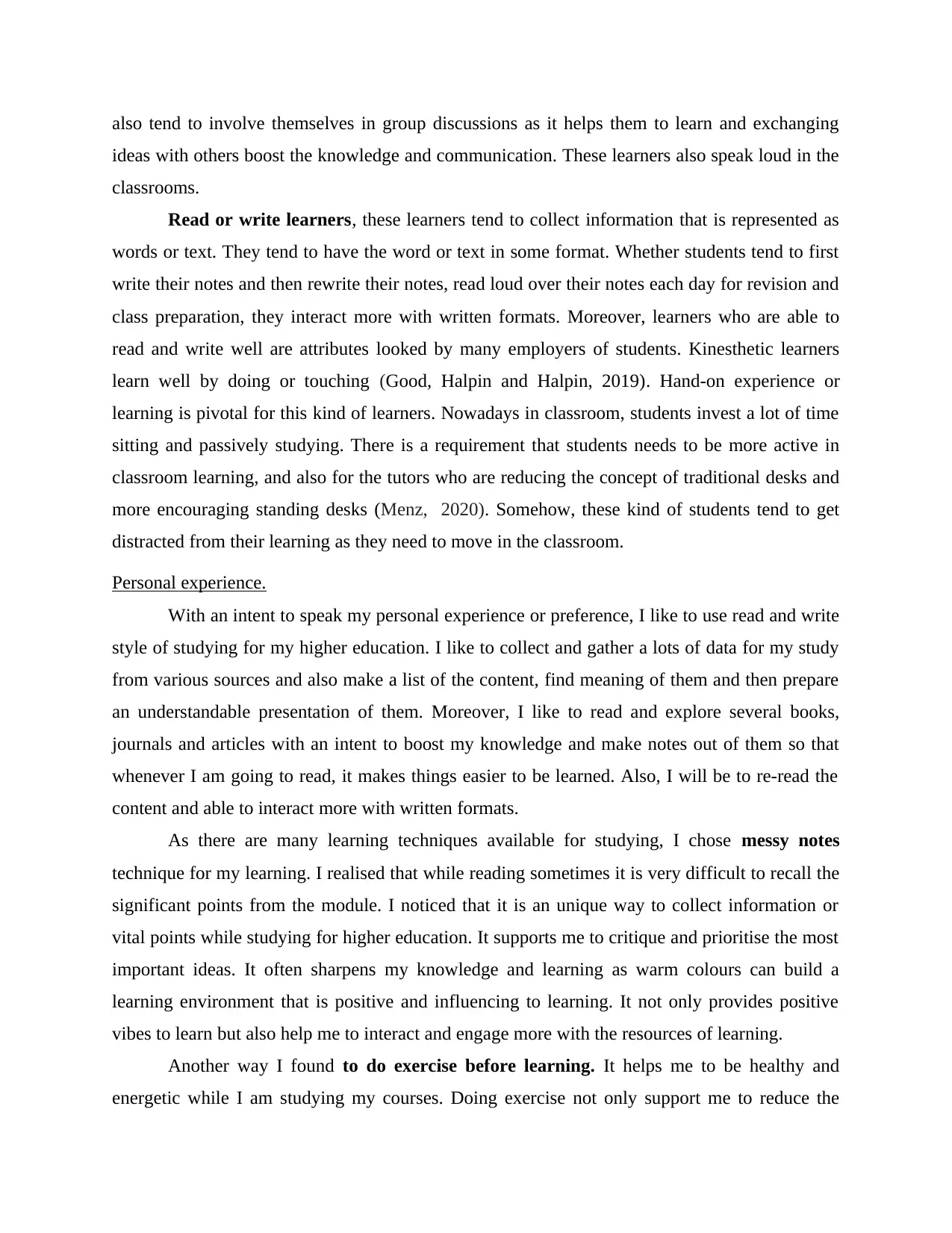
also tend to involve themselves in group discussions as it helps them to learn and exchanging
ideas with others boost the knowledge and communication. These learners also speak loud in the
classrooms.
Read or write learners, these learners tend to collect information that is represented as
words or text. They tend to have the word or text in some format. Whether students tend to first
write their notes and then rewrite their notes, read loud over their notes each day for revision and
class preparation, they interact more with written formats. Moreover, learners who are able to
read and write well are attributes looked by many employers of students. Kinesthetic learners
learn well by doing or touching (Good, Halpin and Halpin, 2019). Hand-on experience or
learning is pivotal for this kind of learners. Nowadays in classroom, students invest a lot of time
sitting and passively studying. There is a requirement that students needs to be more active in
classroom learning, and also for the tutors who are reducing the concept of traditional desks and
more encouraging standing desks (Menz, 2020). Somehow, these kind of students tend to get
distracted from their learning as they need to move in the classroom.
Personal experience.
With an intent to speak my personal experience or preference, I like to use read and write
style of studying for my higher education. I like to collect and gather a lots of data for my study
from various sources and also make a list of the content, find meaning of them and then prepare
an understandable presentation of them. Moreover, I like to read and explore several books,
journals and articles with an intent to boost my knowledge and make notes out of them so that
whenever I am going to read, it makes things easier to be learned. Also, I will be to re-read the
content and able to interact more with written formats.
As there are many learning techniques available for studying, I chose messy notes
technique for my learning. I realised that while reading sometimes it is very difficult to recall the
significant points from the module. I noticed that it is an unique way to collect information or
vital points while studying for higher education. It supports me to critique and prioritise the most
important ideas. It often sharpens my knowledge and learning as warm colours can build a
learning environment that is positive and influencing to learning. It not only provides positive
vibes to learn but also help me to interact and engage more with the resources of learning.
Another way I found to do exercise before learning. It helps me to be healthy and
energetic while I am studying my courses. Doing exercise not only support me to reduce the
ideas with others boost the knowledge and communication. These learners also speak loud in the
classrooms.
Read or write learners, these learners tend to collect information that is represented as
words or text. They tend to have the word or text in some format. Whether students tend to first
write their notes and then rewrite their notes, read loud over their notes each day for revision and
class preparation, they interact more with written formats. Moreover, learners who are able to
read and write well are attributes looked by many employers of students. Kinesthetic learners
learn well by doing or touching (Good, Halpin and Halpin, 2019). Hand-on experience or
learning is pivotal for this kind of learners. Nowadays in classroom, students invest a lot of time
sitting and passively studying. There is a requirement that students needs to be more active in
classroom learning, and also for the tutors who are reducing the concept of traditional desks and
more encouraging standing desks (Menz, 2020). Somehow, these kind of students tend to get
distracted from their learning as they need to move in the classroom.
Personal experience.
With an intent to speak my personal experience or preference, I like to use read and write
style of studying for my higher education. I like to collect and gather a lots of data for my study
from various sources and also make a list of the content, find meaning of them and then prepare
an understandable presentation of them. Moreover, I like to read and explore several books,
journals and articles with an intent to boost my knowledge and make notes out of them so that
whenever I am going to read, it makes things easier to be learned. Also, I will be to re-read the
content and able to interact more with written formats.
As there are many learning techniques available for studying, I chose messy notes
technique for my learning. I realised that while reading sometimes it is very difficult to recall the
significant points from the module. I noticed that it is an unique way to collect information or
vital points while studying for higher education. It supports me to critique and prioritise the most
important ideas. It often sharpens my knowledge and learning as warm colours can build a
learning environment that is positive and influencing to learning. It not only provides positive
vibes to learn but also help me to interact and engage more with the resources of learning.
Another way I found to do exercise before learning. It helps me to be healthy and
energetic while I am studying my courses. Doing exercise not only support me to reduce the
Paraphrase This Document
Need a fresh take? Get an instant paraphrase of this document with our AI Paraphraser
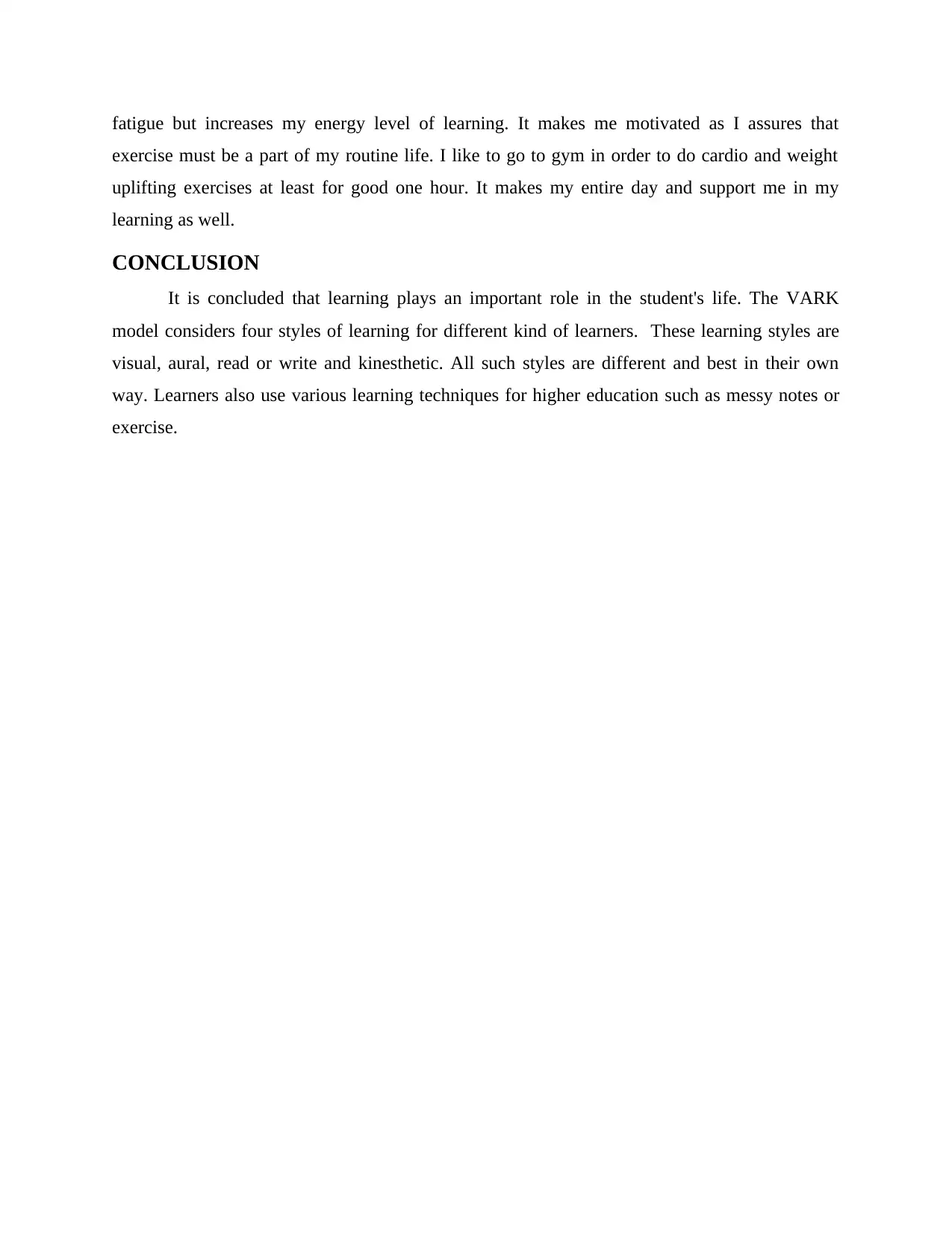
fatigue but increases my energy level of learning. It makes me motivated as I assures that
exercise must be a part of my routine life. I like to go to gym in order to do cardio and weight
uplifting exercises at least for good one hour. It makes my entire day and support me in my
learning as well.
CONCLUSION
It is concluded that learning plays an important role in the student's life. The VARK
model considers four styles of learning for different kind of learners. These learning styles are
visual, aural, read or write and kinesthetic. All such styles are different and best in their own
way. Learners also use various learning techniques for higher education such as messy notes or
exercise.
exercise must be a part of my routine life. I like to go to gym in order to do cardio and weight
uplifting exercises at least for good one hour. It makes my entire day and support me in my
learning as well.
CONCLUSION
It is concluded that learning plays an important role in the student's life. The VARK
model considers four styles of learning for different kind of learners. These learning styles are
visual, aural, read or write and kinesthetic. All such styles are different and best in their own
way. Learners also use various learning techniques for higher education such as messy notes or
exercise.
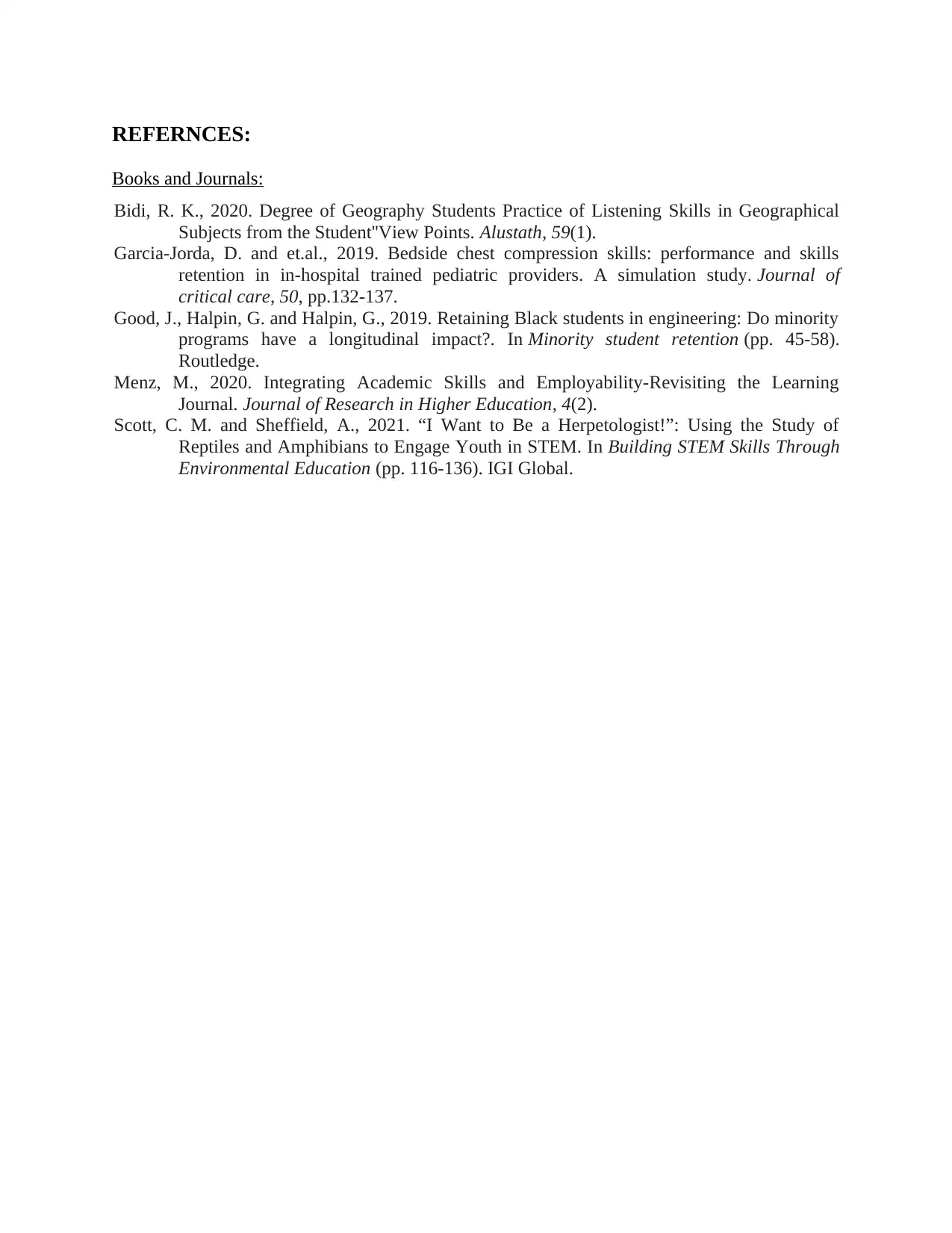
REFERNCES:
Books and Journals:
Bidi, R. K., 2020. Degree of Geography Students Practice of Listening Skills in Geographical
Subjects from the Student''View Points. Alustath, 59(1).
Garcia-Jorda, D. and et.al., 2019. Bedside chest compression skills: performance and skills
retention in in-hospital trained pediatric providers. A simulation study. Journal of
critical care, 50, pp.132-137.
Good, J., Halpin, G. and Halpin, G., 2019. Retaining Black students in engineering: Do minority
programs have a longitudinal impact?. In Minority student retention (pp. 45-58).
Routledge.
Menz, M., 2020. Integrating Academic Skills and Employability-Revisiting the Learning
Journal. Journal of Research in Higher Education, 4(2).
Scott, C. M. and Sheffield, A., 2021. “I Want to Be a Herpetologist!”: Using the Study of
Reptiles and Amphibians to Engage Youth in STEM. In Building STEM Skills Through
Environmental Education (pp. 116-136). IGI Global.
Books and Journals:
Bidi, R. K., 2020. Degree of Geography Students Practice of Listening Skills in Geographical
Subjects from the Student''View Points. Alustath, 59(1).
Garcia-Jorda, D. and et.al., 2019. Bedside chest compression skills: performance and skills
retention in in-hospital trained pediatric providers. A simulation study. Journal of
critical care, 50, pp.132-137.
Good, J., Halpin, G. and Halpin, G., 2019. Retaining Black students in engineering: Do minority
programs have a longitudinal impact?. In Minority student retention (pp. 45-58).
Routledge.
Menz, M., 2020. Integrating Academic Skills and Employability-Revisiting the Learning
Journal. Journal of Research in Higher Education, 4(2).
Scott, C. M. and Sheffield, A., 2021. “I Want to Be a Herpetologist!”: Using the Study of
Reptiles and Amphibians to Engage Youth in STEM. In Building STEM Skills Through
Environmental Education (pp. 116-136). IGI Global.
⊘ This is a preview!⊘
Do you want full access?
Subscribe today to unlock all pages.

Trusted by 1+ million students worldwide
1 out of 6
Related Documents
Your All-in-One AI-Powered Toolkit for Academic Success.
+13062052269
info@desklib.com
Available 24*7 on WhatsApp / Email
![[object Object]](/_next/static/media/star-bottom.7253800d.svg)
Unlock your academic potential
Copyright © 2020–2025 A2Z Services. All Rights Reserved. Developed and managed by ZUCOL.


